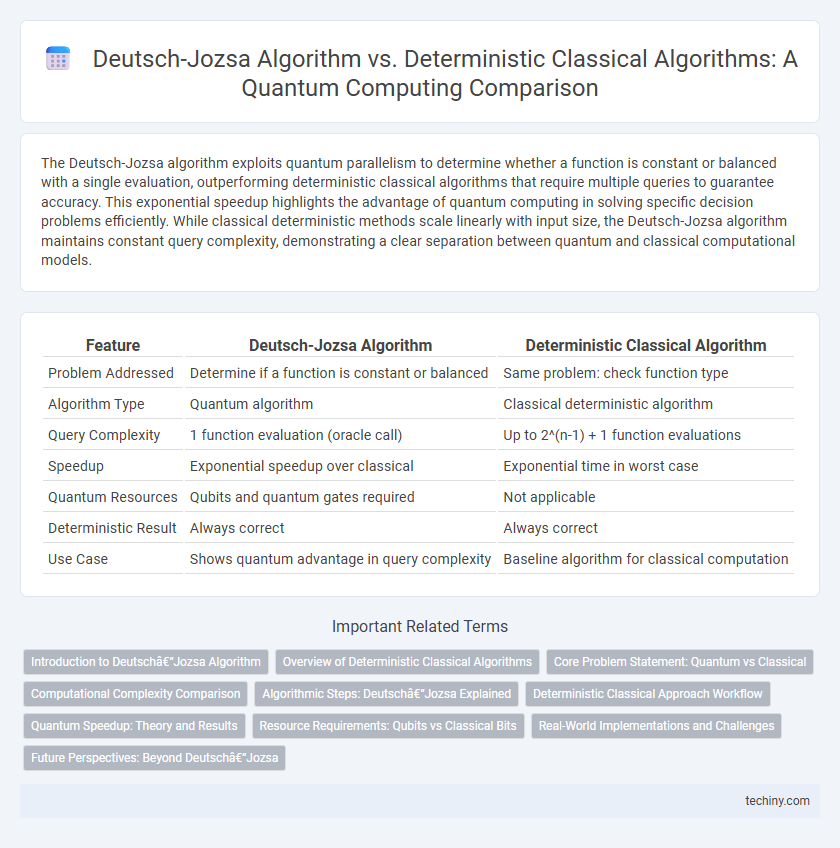The Deutsch-Jozsa algorithm exploits quantum parallelism to determine whether a function is constant or balanced with a single evaluation, outperforming deterministic classical algorithms that require multiple queries to guarantee accuracy. This exponential speedup highlights the advantage of quantum computing in solving specific decision problems efficiently. While classical deterministic methods scale linearly with input size, the Deutsch-Jozsa algorithm maintains constant query complexity, demonstrating a clear separation between quantum and classical computational models.
Table of Comparison
| Feature | Deutsch-Jozsa Algorithm | Deterministic Classical Algorithm |
|---|---|---|
| Problem Addressed | Determine if a function is constant or balanced | Same problem: check function type |
| Algorithm Type | Quantum algorithm | Classical deterministic algorithm |
| Query Complexity | 1 function evaluation (oracle call) | Up to 2^(n-1) + 1 function evaluations |
| Speedup | Exponential speedup over classical | Exponential time in worst case |
| Quantum Resources | Qubits and quantum gates required | Not applicable |
| Deterministic Result | Always correct | Always correct |
| Use Case | Shows quantum advantage in query complexity | Baseline algorithm for classical computation |
Introduction to Deutsch–Jozsa Algorithm
The Deutsch-Jozsa algorithm, a cornerstone in quantum computing, efficiently determines whether a given function is constant or balanced by leveraging quantum parallelism and superposition. Unlike deterministic classical algorithms that require multiple evaluations to conclusively solve this problem, the Deutsch-Jozsa algorithm achieves the result with a single quantum query, demonstrating exponential speedup. This algorithm exemplifies the potential of quantum computation to outperform classical counterparts in specific decision problems.
Overview of Deterministic Classical Algorithms
Deterministic classical algorithms solve the Deutsch-Jozsa problem by evaluating the function on multiple inputs to determine if it is constant or balanced, requiring exponential query complexity in the worst case. These algorithms rely on exhaustive checking or structured testing sequences without probabilistic elements, contrasting with quantum counterparts. Their inefficiency in query complexity highlights the advantage of quantum algorithms in solving specific decision problems faster.
Core Problem Statement: Quantum vs Classical
The Deutsch-Jozsa algorithm solves the core problem of determining whether a given function is constant or balanced with a single quantum query, showcasing exponential speedup over deterministic classical algorithms that require exponentially many queries. Classical deterministic algorithms must evaluate multiple inputs to guarantee correctness, resulting in an O(2^(n-1)) complexity for n-bit functions. This stark contrast highlights the quantum advantage in evaluating global properties of functions through superposition and interference.
Computational Complexity Comparison
The Deutsch-Jozsa algorithm exhibits an exponential speedup over deterministic classical algorithms by solving the problem in a single quantum query compared to the classical approach requiring 2^(n-1) + 1 queries for an n-bit input. This quantum advantage arises from the algorithm's ability to evaluate global properties of a function using superposition and interference, drastically reducing computational complexity from exponential to constant time. Consequently, the Deutsch-Jozsa algorithm highlights the potential of quantum computing to outperform classical deterministic methods in specific problem classes.
Algorithmic Steps: Deutsch–Jozsa Explained
The Deutsch-Jozsa algorithm begins by initializing qubits into a superposition using Hadamard gates, enabling simultaneous evaluation of all input states. It then applies the oracle function, which encodes the Boolean function to be tested, followed by a second round of Hadamard gates to interfere qubit states constructively or destructively. Measurement of the qubits reveals with a single query whether the function is constant or balanced, demonstrating exponential speedup over deterministic classical algorithms that require multiple evaluations.
Deterministic Classical Approach Workflow
The deterministic classical algorithm for solving the Deutsch-Jozsa problem evaluates the function for more than half of the possible inputs to guarantee correct classification of the function as constant or balanced. This approach requires exponential time, specifically O(2^{n-1} + 1) queries for an n-bit input, making it inefficient compared to quantum methods. The classical workflow involves sequentially checking function outputs and comparing them to detect inconsistencies, ensuring error-free results at the cost of computational resources.
Quantum Speedup: Theory and Results
The Deutsch-Jozsa algorithm demonstrates quantum speedup by solving the problem of determining whether a function is constant or balanced with a single query, compared to the deterministic classical algorithm that requires exponentially many queries in the worst case. This quantum advantage arises from quantum parallelism and interference, enabling distinct evaluation of all inputs simultaneously. The algorithm serves as a theoretical cornerstone showcasing the potential exponential speedup quantum computing offers over classical deterministic approaches.
Resource Requirements: Qubits vs Classical Bits
The Deutsch-Jozsa algorithm requires a linear number of qubits relative to the input size, enabling exponential speedup over deterministic classical algorithms that rely on exponentially many classical bits for function evaluation. Quantum parallelism allows the algorithm to determine whether a function is constant or balanced using a single quantum query, whereas classical deterministic algorithms must evaluate multiple inputs, consuming significantly more bits and computational resources. This resource efficiency highlights the advantage of quantum qubits in solving specific problems with fewer computational steps and less memory overhead compared to classical bits.
Real-World Implementations and Challenges
The Deutsch-Jozsa algorithm demonstrates exponential speedup over deterministic classical algorithms by solving specific problems with a single query, highlighting the potential of quantum computing in real-world applications such as cryptography and optimization. Practical implementation challenges include error rates in quantum gates, qubit decoherence, and scalability issues in current quantum hardware platforms like superconducting circuits and trapped ions. Overcoming these obstacles requires advancements in quantum error correction, fault-tolerant architectures, and hybrid quantum-classical systems to fully realize the algorithm's efficiency in practical computational tasks.
Future Perspectives: Beyond Deutsch–Jozsa
Quantum computing algorithms like the Deutsch-Jozsa algorithm demonstrate exponential speedup over deterministic classical algorithms in identifying balanced versus constant functions with a single query. Future perspectives extend beyond Deutsch-Jozsa, focusing on developing hybrid quantum-classical algorithms and error-corrected quantum processors to tackle more complex problems such as optimization, cryptography, and machine learning. Emerging quantum algorithms seek to harness quantum parallelism and entanglement to surpass classical limits in computational efficiency and real-world applications.
Deutsch–Jozsa Algorithm vs Deterministic Classical Algorithm Infographic

 techiny.com
techiny.com